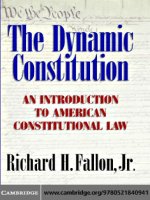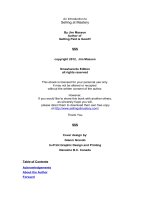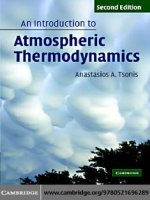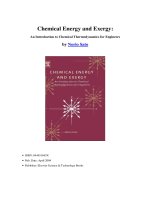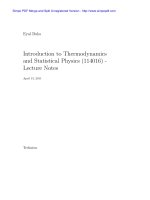An Introduction to Thermodynamics phần 7 pot
Bạn đang xem bản rút gọn của tài liệu. Xem và tải ngay bản đầy đủ của tài liệu tại đây (113.98 KB, 13 trang )
7/10/07 3- 79
f = p(c - 1) + 2 - c(p - 1)
= c - p + 2 (36)
Figure 5. Each area
corresponds to a single
phase. The lines are the
common borders, and
thus represent two phases
in equilibrium (or three
phases at a point)
which is Gibbs’ phase rule, for two external degrees of freedom.
You will recall from experience with drawing graphs that a point (or any finite number of
points) corresponds to no degrees of freedom. A line (or a finite number of lines) represents one
degree of freedom; setting one variable determines the other. Two degrees of freedom yield an
area (or more than one area).
ONE-COMPONENT PHASE DIAGRAMS. Water is a single component (c = 1), so the degrees of
freedom may vary from zero to two.
(c = 1) f = c - p + 2 = 3 - p (37)
A single phase (vapor, liquid, or solid) is therefore represented by an area. Two phases (solid-
liquid, solid-vapor, or vapor-liquid) are restricted to a line. Three phases yield a single point,
called the triple point (solid + liquid + vapor). The phase diagram (with T on the vertical axis, to
match following diagrams) is shown in Figure 5.
You can calculate the slopes of the three lines from the Clapeyron and Clausius-Clapeyron
equations, knowing the heats of fusion and of vaporization or sublimation and the densities of the
phases. The upper end of the liquid-vapor line simply stops — above the critical point the
distinction between liquid and vapor disappears.
TWO-COMPONENT PHASE DIAGRAMS AT CONSTANT PRESSURE. We could not represent a single
phase with two components on a two-dimensional page if we kept both temperature and pressure
as external variables. We consider here the restricted example where pressure is maintained
constant (e.g., at atmospheric pressure). Then Gibbs’ phase rule tells us the degrees of freedom
are, again, with c = 2,
(c = 2; const P) f = c - p + 1 = 3 - p (38)
It follows that wherever there is a single phase present, that phase must be represented by an area
(two degrees of freedom). If there are two phases present, the compositions are restricted to a
line (or sometimes more than one line, but still one degree of freedom). Three phases can coexist
7/10/07 3- 80
only at a point, or a set of
points, with no remaining
degrees of freedom.
Accordingly, an area can
represent only a region in
which there is a single phase,
of variable composition.
There are two apparent
exceptions. First, the
solubility of one solid in
another is typically so
Figure 3.6. Benzene-toluene equilibrium (liquid-vapor, at constant pressure). a) Calculated equilibrium
states. b) Phase diagram. The area between the curved lines is not part of the equilibrium phase diagram.
There can be no phase of such temperature and composition.
small that the area of a “pure” solid will look like a single, vertical line. Second, when two
phases, solid or liquid, are in equilibrium, those two phases will have different compositions and
therefore different areas, bordered by lines that are separated from each other, as in the benzene-
toluene diagram of Figure 6. Each line is simply the border of its respective area. If the overall
composition falls between those lines, or areas, the material will split into variable amounts of the
left and right areas (phases). The region between phases has been given the unfortunate label of a
“two phase” region; a better description is a forbidden area. There can be no phase present with
a composition falling in such a forbidden area. The relative amounts of the left phase and right
phase are given by the lever-arm rule. If C and C are the compositions (as percentages of either
L R
phase — say the left-hand phase) and C is the overall composition of the mix at some point, the
relative amounts (masses) of the left-hand and right-hand phases are given by
m (C - C ) = m (C - C) (39)
1 L 2 R
Similar behavior is shown by two immiscible solids or two immiscible liquids. Carbon
tetrachloride and water liquids split into two layers, with very little solubility of either liquid in the
other. At higher temperatures, however, the vapors mix freely. Thus the basic phase diagram is
as shown in Figure 7a. There are three possible phases: the vapor, at higher temperatures, liquid
CCl at room temperature and below, and liquid water. The two liquid phases can co-exist, but
4
there is no liquid phase with composition falling in the general range of 95% CCl /5% water to
4
95% water/5% CCl (where the numbers are illustrative only, and depend somewhat on
4
temperature). Figure 7a is somewhat difficult to interpret, so it is customary to add a horizontal
line as a marker, to dramatize the lowest vapor temperature of the mixture, as in Figure 7b.
(There can be no equilibrium across a horizontal line, which would connect points at different
temperatures.) Also, if the diagram represents solid-liquid equilibrium, as for silver and copper in
Figure 7c, it was recognized long before Gibbs’ work of the late 19 century that when the liquid
th
7/10/07 3- 81
solution is cooled, either silver or copper will precipitate out first (depending on whether the
composition lies to the left or right of the low point, called the eutectic). The composition of the
remaining liquid accordingly moves toward the eutectic composition. In the last stage of
precipitation, or freezing, the mixture that comes down is a fine mix of two phases, silver and
copper, with the overall composition of the eutectic. Accordingly, a vertical line was drawn
below the eutectic point to represent this eutectic mixture — two distinct phases, but with a
distinctive appearance. Over decades, the vertical line was changed to a dotted line (to
a b c
Figure 3.7. a) Bare-bones phase diagram for two immiscible phases with miscible high-
temperature phase (e.g., CCl and H O, liquid-vapor, or Silver-Copper, solid-liquid). b) The
4 2
horizontal line guides the eye. c) Early diagrams showed the eutectic mixture as if it were a
separate phase, or (later) as a dotted line.
indicate there is no phase with composition falling in this broad forbidden region) and more
recently the vertical line is largely omitted.
Examining a large number of such phase diagrams, the two patterns shown here will be
recognized as appearing in combination. Often a solid compound forms, so the diagram can
conceptually be divided in two, element one plus compound on the left and compound plus
element two on the right. There may be regions of solubility, resembling the benzene-toluene
diagram, within a larger phase diagram. Some compounds may spontaneously decompose as the
temperature rises, yielding separate phases. The variety is seemingly endless. But almost all can
be recognized as relatively simple combinations of these two basic patterns.
Problems
1. For the transformation of graphite to diamond at 25 C, ∆G = 2.9 kJ/mole. The densities are
o
2.25 and 3.51 g/cm . What is the minimum pressure required to make diamond
3
thermodynamically stable at this temperature?
2. At 1114 C the vapor pressure of Ni was observed to be 7.50 x 10 torr and at 1142 C it was
o -8 o
14.33 x 10 torr. What is the heat of vaporization of nickel in this range?
-8
3. Is the fugacity of ice increased or decreased by exerting pressure on the ice? Which will show
the greatest change in fugacity for a pressure increase of 10 atm: ice, or liquid water? Explain.
4. The vapor pressure of a liquid compound, Y, obeys the equation ln P = a + bT , with P the
-1
pressure in atm and T in kelvin.
.90.0
)H/CC(HgBr
O)/HC(HgBr
66 2
2 2
=
7/10/07 3- 82
a. What is the boiling point of Y?
b. What is the heat of vaporization at the normal boiling point?
5. Find the mole fractions of the several components if 24 g of methane, CH , is mixed with 7 g
4
of CO, 14 g of N , and 8 g of He.
2
6. A saturated solution of benzoic acid, C H COOH, contains 0.32 g in 100 g of water. The
6 5
density of the solution is 1.3 g/cm . What is the molarity of the solution?
3
7. Find the mole fraction, molarity, and molality of iodine when 0.10 g of iodine is dissolved in
100 g of CCl (density 1.59 g/cm ).
4
3
8. a. What is the molarity of water in pure water?
b. What is the molality of water in pure water?
c. What is the molarity of CCl in pure CCl (density 1.59 g/cm )?
4 4
3
d. What is the molality of CCl in pure CCl ?
4 4
e. What is the molarity of an ideal gas at 1 atm and 25 C?
o
9. A solution contains, by weight, 40% water, 35% ethanol (C H OH), and 25% acetone
2 5
(CH COCH ).
3 3
a. Find the mole fraction of each component.
b. Find the molality of the ethanol and acetone if water is considered to be the solvent.
c. Find the molality of the water and acetone if the ethanol is considered to be the solvent.
10. The solubility of CCl in water at room temperature is about 0.9 g/L and the vapor pressure
4
of CCl is about 100 torr. What would be the equilibrium vapor pressure of CCl above a beaker
4 4
containing CCl covered with a layer of water?
4
11. Water in equilibrium with air (20.9% O , 79.1% N by pressure, volume, or mole fraction) at
2 2
0 C contains 1.28 x 10 mole of air per liter, of which 34.91% is O . Calculate the Henry’s law
o -3
2
constant
a. for O
2
b. for N
2
12. Is the Henry’s law constant for benzene in water large or small?
13. The distribution coefficient for mercuric bromide, HgBr , between water and benzene is 0.90.
2
That is, with concentrations expressed as molarities,
An aqueous solution contains 0.010 M HgBr . 50 ml of this solution is to be extracted with 150
2
ml of benzene.
a. What fraction of the HgBr is left in the aqueous phase if the extraction is made with one
2
150 ml portion of benzene?
b. What fraction is left if the extraction is made with three successive 50 ml portions of
benzene?
14. Over a certain range of concentrations, the volume of a solution containing m moles of NaCl
in 1 kg water has been found to be, in ml,
V = 1002.935 + 16.670 m + 1.636 m + 0.170 m
3/2 2
Find the partial molal volume of
a. NaCl in a 2 m solution
b. water in a 2 m NaCl solution
c. pure NaCl (density 2.165 g/cm )
3
2
1
1
RT
TH
N
∆∆
=∆
)(
111
BA
HHH −=∆
7/10/07 3- 83
15. The vapor pressures of benzene and toluene, at 27 C, are 120 and 40 torr. Assuming an ideal
o
solution, what is the composition of the vapor above a solution containing 100 g of benzene
(C H ) and 150 g of toluene (C H CH )?
6 6 6 5 3
16. In your work for Adulterated Chemicals, Inc., you have isolated a new antibiotic through a
lengthy series of extractions, biological tests, and so forth. A few milligrams are available, and by
the ultra-centrifuge method it has been found that the molar mass is 10,000. It is desired to check
this by another method. For a 1% by weight solution of the substance in water, calculate
a. the freezing-point depression
b. the boiling-point elevation
c. the change in vapor pressure at 25 C
o
d. the osmotic pressure, at 25 C, in cm H O. (The density of mercury is 13.6 g/cm .)
o 3
2
Which method would you recommend?
17. Boiling occurs in a solution when the sum of the vapor pressures of the components is equal
to the atmospheric pressure (or the applied pressure), but these vapor pressures are lower than for
the pure materials (cf. Raoult’s law, equation 29c). If two liquids are immiscible, each exhibits its
own vapor pressure (in each phase), and “steam distillation” occurs when the sum of the vapor
pressures is equal to the atmospheric pressure.
a. Calculate the vapor pressure of pure water at 99 C.
o
b. What vapor pressure must a compound, immiscible with water, have to steam distill at
99 C when the atmospheric pressure is 745 torr?
o
c. What would be the composition of the vapor in such a steam distillation?
18. A solution of 3.795 g of sulfur in 100 g of CS boils at 46.66 C. The boiling point of pure
2
o
CS is 46.30 C and the heat of vaporization of CS is 26.8 kJ/mol. From this experimental result,
2 2
o
what is the probable formula of the sulfur molecule in the solution?
19. Show that if two phases (A and B) in equilibrium are both slightly impure, the resultant
change in temperature (change in melting point or boiling point, relative to pure phases), ∆T, is
given by
where ∆N is the difference in mole fraction of the major component (∆N = N - N ) and ∆H is
1 1 1 1 1
A B
the enthalpy of transition .
(1)
reactantsproducts
BADC
jjii
GbGaGdGc
GnGnG
−−+=
−=∆
∑
∑
(2)
o
B
o
A
o
D
o
C
o
GbGaGdGcG −−+=∆
7/10/07 4- 84
4 Chemical Equilibrium
Chemical equilibrium is one of the most important applications of thermodynamics. The
theory follows very simply from the equations already derived. Setting up the necessary
equations in practice requires only an understanding of the meaning of a chemical equation. Most
mistakes arise in the elementary process of counting the molecules or moles of reactants and
products.
For some systems the solution of the mathematical equations requires some skill and,
especially, some understanding of the physical implications so that reasonable assumptions and
approximations can be made. For the types of problems considered here, the primary requirement
is to follow a simple, methodical procedure in finding the appropriate equations, and then to insert
numerical values into these equations. Solution of the equations is then quite easy.
Free-Energy Changes in Chemical Reactions
A completely general chemical reaction may be represented in the form
aA + bB 6 cC + dD
This should be interpreted as follows: Under certain conditions of overall temperature, pressure,
and concentrations of A, B, C, and D (not yet specified here), a moles of substance A react with b
moles of substance B to form c moles of substance C and d moles of substance D. Although
some of the reactants (A and B and perhaps others) are consumed and some products (C and D
and perhaps others) are formed, it is assumed that there is no change in temperature, in pressure,
or in concentrations of any of the substances as a consequence of the chemical reaction.
The free-energy change, if the reaction proceeds as written, will be
The values of the partial molal, or effective, free energies on the right-hand side depend on the
states of these compounds, including the temperature, the pressure, and the individual
concentrations. Thus ∆G may have any value, depending on the states of reactants and products.
Remember that, for purposes of the calculation, the states of reactants and products are
unchanged by the reaction. The temperature, pressure, and concentration of each substance is the
same before and after the reaction. The reaction may involve a negligible fraction of the
substances present, or reactants may be added and products removed as the reaction proceeds.
Tables give ∆G = ∆G for the reaction occurring with all reactants and products in their
o
standard states.
(
)
(
)
(
)
(
)
(3)
o
BB
o
AA
o
DD
o
CC
o
GGbGGaGGdGGcGG −−−−−+−=∆−∆
(
)
( )
TBfRTG
TBfRTG
i
o
i
o
i
iii
+=
+=
ln and
ln
(4) ln
o
i
i
o
ii
f
f
RTGG =−
−−+=∆−∆
o
B
B
o
A
A
o
D
D
o
C
C
o
f
f
b
f
f
a
f
f
d
f
f
cRTGG lnlnlnln
(5)
o
i
i
i
f
f
a =
(
)
b
B
a
A
d
D
c
C
o
aaaaRTGG lnlnlnln −−+=∆−∆
(6) ln
b
B
a
A
d
D
c
C
o
aa
aa
RTGG +∆=∆
(
)
(7) ln aRTGG
o
Q
+∆=∆
( )
(8)
b
B
a
A
d
D
c
C
aa
aa
a =Q
7/10/07 4- 85
Subtraction of equation 2 from equation 1 gives
At this point it is convenient to substitute the fugacities (equation 7a, Chapter 3) for the free-
energy terms.
Therefore,
Substitution of equation 4 into equation 3, for each of the substances, gives
The ratio of the fugacity of any substance, f , to the fugacity of the same substance in its standard
i
state, f , is called the “activity”, a .
i i
o
It follows from the definition that activity is always dimensionless and without units. Substitution
of activity for the ratio of fugacities and replacement of n ln x by ln x gives
n
which can be further simplified to the form
It will be convenient to write this in the form
defining
Q
(a) to be
(
)
( )
(9)
atm 1
atm
atm
P
P
f
f
a
o
===
More generally, the standard state of any gas is taken as the ideal gas at 1 atm pressure;
1
that is, it is a fictitious state with properties obtained from the properties of the actual gas, at
sufficiently low pressures that the gas is ideal, extrapolated to 1 atm pressure using the equations
for behavior of an ideal gas. The numerical value of the activity coefficient is the ratio of the
fugacity of the real gas to that of the idealized gas. The dimensions are reciprocal pressure.
7/10/07 4- 86
or the corresponding form appropriate to the particular reaction.
Equation 6 is a very important result with obvious physical interpretation. If all substances
(reactants and products) are in their standard states, all activities are, by definition, equal to 1.
Then
Q
(a) = 1, ln
Q
(a) = 0, and ∆G = ∆G . The correction term depends on the value of
Q
(a),
o
which depends on the individual activities and therefore on the fugacities, or on the pressure and
concentration of each substance at the given temperature.
Standard States
The choice of standard states affects the value of ∆G as it appears in tables, and determines
o
the relationship between the state of a compound and its activity. There are certain conventions
that are customarily followed, so that it is generally considered unnecessary to explain in detail
the choice of standard states that has been made. Unless the conventions are understood,
therefore, it may not be possible to apply thermodynamic values found in the literature. Standard
states are chosen to give a convenient form for the activity.
GASES. For an ideal gas, fugacity is equal to pressure. We choose the standard state to be 1 atm
pressure. Then f = P, f = P = 1 atm:
o o
That is, the activity, which is a dimensionless ratio, is equal to the numerical value of the pressure,
with the pressure expressed in atmospheres. This simple relationship can be extended to cover
real gases by the introduction of an “activity coefficient”, γ (Greek gamma), that will equal 1 if the
gas is ideal, and will differ from 1 as the gas deviates from ideality.
a = γP (10)
The activity coefficient defined in this way has units of atm . Equation 10 is applicable to any
-1
gas, real or ideal. If the gas is non-ideal, it is necessary to know the value of γ.
1
LIQUIDS AND SOLUTIONS. The major component of an ideal solution has a fugacity given by
Raoult’s law —
(11)
1
1
1
1
N
f
f
a
o
==
(12)
111
Na
γ
=
(13)
2
2
2
2
2
c
k
f
f
f
a
o
===
7/10/07 4- 87
f = f N
1 1 1
o
— in which f is the fugacity of the pure solvent. We choose the pure solvent as the standard
1
o
state so that f is the fugacity in the standard state. Then
1
o
Thus the activity of the solvent is equal to its mole fraction, in the ideal solution, and the activity
of any pure liquid is 1. Not all solutions are ideal, so it is convenient to allow for deviations from
Raoult’s law by introducing an activity coefficient, as for gases, defined by the equation
This activity coefficient is dimensionless. It will be 1 for a pure liquid, for a solvent in an infinitely
dilute solution, or for a component of an ideal solution. It may differ appreciably from 1 when the
fugacity of the liquid in solution deviates from Raoult’s law.
If a solute obeys Henry’s law, the fugacity is proportional to concentration and the standard
state of the solute may be chosen such that f = k, the Henry’s law constant (even though such a
2
o
standard state may be physically unattainable). Then
with |c | representing the numerical value of c . For any particular concentration, the value of the
2 2
activity depends on the units chosen for expressing concentration. Common choices are molarity,
molality, or sometimes mole fraction (especially when the choice between solute and solvent is
ambiguous). Activity is dimensionless but the activity coefficient has dimensions of inverse
concentration. For example, if c is in mole per liter, γ has units of liter per mole. In any case,
2 2
a = γ c
2 2 2
Molality has some advantages in accommodating changing temperature. Nevertheless, in
subsequent discussions we will assume the concentration of solute is expressed as molarity. For
dilute water solutions the difference between molarity and molality is negligible.
Concentrated solutions may show large deviations from Henry’s law, as a consequence of
large intermolecular forces. This may also occur with uncharged solutes, leading, for example, to
a maximum-boiling or minimum-boiling solution, known as an azeotrope. It is also expected for
multiply charged ions (which typically form complex ions of smaller charge). In dilute solutions,
activity coefficients of ions are less than 1, approaching 1 at infinite dilution. Activity coefficients
of ions in concentrated solutions (on the order of 1 M) may increase and become greater than 1.
Strong electrolytes fully dissociate in aqueous solution, so the concentration of undissociated
electrolyte may be assumed to be vanishingly small. We can eliminate consideration of the
undissociated electrolyte by defining its activity to be equal to the product of the activities of the
ions into which it dissociates. Then the equilibrium constant for the dissociation is 1, ∆G for the
o
( ) ( )
dTCTHTH
T
P
∫
+=
2
1
T
12
S
T
G
P
−=
∂
∂
It is possible to assign an arbitrary absolute value for entropy, but such methods always
2
omit some parts of S, and thus should be regarded as indeterminate. Note, however, that this
limitation does not apply to finding the change in ∆G (as, for example, in finding the change in
∆G ) with change in temperature. This change depends on ∆S, which can be measured. The
reaction
temperature dependence of fugacity can also be found.
7/10/07 4- 88
dissociation is zero, and the irrelevant quantities disappear from the calculations.
SOLIDS. The fugacity of a solid is very nearly constant, at a given temperature, independent of
the applied pressure (except for extreme pressures). We choose this normal value of the fugacity
as f , so the solid has an activity of 1. Appreciable deviations from unit activity for a solid may
o
be expected only under very high pressures, when impurities are present (as in mercury-metal
amalgams), when the solid is severely strained, or when the solid exists as extremely small
particles for which surface effects cannot be neglected.
VARIATIONS AND LIMITATION. Other choices of standard states are possible and may be
convenient for special circumstances. For example, the standard state of a gas may be taken as a
concentration of 1 mol/L rather than at 1 atm. Such a choice seldom, if ever, appears in tables of
standard free energies, but may occasionally be found, especially in introductory discussions, for
applications to chemical equilibria.
There is an important distinction between the choices of standard states for enthalpy and for
free energy. Both are commonly taken for 1 atm pressure and for the most stable phase under the
standard conditions. However, enthalpies are given for a fixed temperature, usually 25 C (but
o
sometimes 18 C). Corrections for other temperatures are made by calculations involving the heat
o
capacity.
On the other hand, the temperature dependence of the free energy is given by equation 23,
Chapter 2,
We have defined entropy only through ∆S, and therefore subject to an arbitrary additive constant.
The change in free energy with temperature is thus also subject to an arbitrary additive constant,
and therefore is unknown. It is therefore necessary to choose the standard state for the
2
specification of free energy to be at the temperature of interest.
CALCULATIONS. We are now prepared to calculate free-energy changes for specific chemical
reactions for particular choices of conditions. Consider first the reaction for the synthesis of
ammonia at 25 C when each of the three gases is present at a partial pressure of 5 atm. The
o
standard free-energy change, ∆G , is - 16.64 J/mol (NH ). Assume the gases are ideal.
o
3
( ) ( )
( ) ( )
)(NH kJ/mol 62.20
25
5
ln478,2640,16ln
ln
3
2/32/1
2/32/1
22
3
22
3
−=
+−=+∆=
+∆=∆
HN
NH
o
HN
NH
o
PP
P
RTG
aa
a
RTGG
(
)
(
)
OAg
2/1
O
2
Ag
2
2
ln
a
aa
RTGG
o
+∆=∆
(
)
(
)
kJ/mol
1.150
-
10ln 2478559001010ln 298314.855900
10
2
34
=
+=⋅+=∆
−−−
G
7/10/07 4- 89
½ N + 3/2 H 6 NH
2 2 3
The standard free-energy change for the decomposition of Ag O at 25 C is 10.84 kJ/mol.
2
o
The free-energy change for Ag O in air (20% O ) will be slightly different:
2 2
Ag O 6 2 Ag + ½ O
2 2
Activities of the solids are 1 and the activity of the oxygen is 0.20 (equal to the pressure in
atmospheres).
∆G = 10,840+8.314 x 298 ln (0.20) = 10,840 - 1,239 ln 5
½
= 8.846 kJ/mol
The free-energy change for the dissolution of CaF in water at 25 C, containing 0.001 M NaF
2
o
and 0.0001 M CaCl may be calculated as follows. The standard free energies of solid CaF and
2 2
of CaF as a solute are -1,162 and -1,106 kJ/mol. Thus ∆G for the dissolution process is 55.90
2
o
kJ/mol.
CaF 6 Ca + 2 F
2
++ -
Setting a ++ = |c ++| = 0.0001 and a - = |c -| = 0.001 gives
Ca Ca F F
The dissolution of HCl gas, at a pressure of 0.10 atm, is somewhat less spontaneous if the
water contains 0.50 M HCl. The standard free energies of HCl(g) and HCl(aq) are - 95.27 and
- 131.2 kJ/mol, so ∆Go = - 131.2 - (- 95.27) = - 35.9 kJ/mol, and (by chosen convention) a
HCl(aq)
= a · a
H
+ Cl
( )( )
J/mol
6
.
33
10.0
50.050.0
ln 298314.89.35
ln
)(
−
=
⋅+−=
+∆=∆
−+
gHCl
ClH
o
a
aa
RTGG
( )
(15) lnG
or
lnln0
o
eq
b
B
a
A
d
D
c
C
eq
o
eq
b
B
a
A
d
D
c
C
o
aa
aa
RT
aRTG
aa
aa
RTG
−=∆
+∆=
+∆=
Q
( )
(16) K
aa
aa
a
eq
b
B
a
A
d
D
c
C
eq
=
=
Q
Undoubtedly part of the difficulty (whether cause or consequence of the confusion) is
3
that many textbooks state that the equilibrium constant depends on pressure or on the presence of
other substances, but this is because they are not talking about the equilibrium constant but rather
the value of
Q
(c) at equilibrium, which is not necessarily a constant. The “changes in the
equilibrium constant” referred to are really changes in the activity coefficients, or changes in the
deviations from ideality. The true equilibrium constant (or “thermodynamic equilibrium
constant”) is rigorously constant!
7/10/07 4- 90
Equilibrium Constants
At equilibrium, under constant temperature and pressure, the free-energy change is zero and
equation 6 becomes
For any given reaction, the left-hand side, ∆G , is a constant, obtainable from handbook tables. It
o
depends only on (1) the choice of standard states, and (2) the temperature. Therefore, at any
given temperature the right-hand side of equation 15 — and therefore
Q
(a) — must also be a
eq
constant, which is called the equilibrium constant, K (or K ).
eq
This equation is really quite a remarkable result, and one that students are often unwilling to
accept in its full implications. It says that, despite changes of pressure, concentrations of
reactants or products, or the presence of other substances, the particular function of activities
represented by
Q
(a) can assume only one value at equilibrium, for a given temperature and
choice of standard states by which the activities are defined. The value of
Q
(a) at equilibrium is
3
determined by equation 15, which can be rewritten as
(
)
(
)
3-
2/32/1
10
x
2
.
1
ln J/mol 640,16
3
22
=
−==∆
=
K
KRTG
a
aa
K
o
NH
HN
(
)
(
)
( )
3-
2/32/1
10 x 2.1
2
2/32/
=
− x
xx
7/10/07 4- 91
∆G = - RT ln K (17)
o
This equation was derived without benefit of arbitrary assumptions, so it must be satisfied for all
chemical equilibria.
There is a strong tendency to misinterpret equation 17. The left-hand side refers to standard
state conditions, the right-hand side to equilibrium conditions, but these are not the same. It may
be helpful to think of the equation in an expanded form:
(∆G) - (∆G) = RT ln
Q
- RT ln
Q
std st equil std st equil
Now we recognize that (∆G) = ∆G , (∆G) = 0,
Q
= 1 and ln 1 = 0, and
Q
= K.
std st equil std st equil
o
Therefore the equation may be written as
∆G - 0 = 0 - RT ln K
o
which may be interpreted as saying that ∆G is a measure of how far the standard-state
o
concentrations (or activities) differ from an equilibrium point, and the equilibrium constant is a
measure of how much the equilibrium concentrations (or activities) differ from their standard-
state values (activities equal to 1). The minus sign shows that the left-hand (standard state) side
deviation from equilibrium is equal and opposite to the right-hand (equilibrium) side deviation
from standard states.
Application of the equilibrium constant is straightforward if each step is taken in turn.
Consider, for example, the problem of finding the equilibrium pressures of N and H formed by
2 2
decomposition of ammonia, initially at 2 atm, at 25 C.
o
NH 6 ½ N + 3/2 H
3 2 2
In a gaseous system, activities are equal to pressures in atm (assuming ideal gas behavior).
The pressures, in turn, are proportional to the numbers of moles so, for a given volume and
temperature, it is convenient to think of the chemical reaction in terms of pressures (rather than
just moles). Thus, if the initial pressure of NH is 2 atm and x atm decomposes, the chemical
3
equation states that x/2 atm of N and 3x/2 atm of H will be produced, with 2 - x atm of NH
2 2 3
remaining. The equilibrium condition requires that
